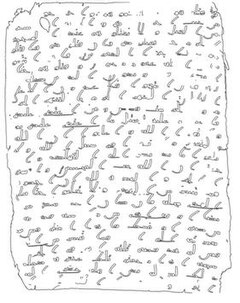
Back مخطوطات صنعاء Arabic Quranın Səna əlyazması Azerbaijani Kodeksê Sena DIQ نسخههای خطی صنعا Persian Sanaan käsikirjoitukset Finnish Manuscrits de Sanaa French Manuskrip Sana'a ID Manoscritti di San'a Italian Sanaa-manuscript Dutch Sana'a el yazmaları Turkish


| Quran |
|---|
The Sanaa palimpsest (also Ṣanʽā’ 1 or DAM 01-27.1) or Sanaa Quran is one of the oldest Quranic manuscripts in existence.[1] Part of a sizable cache of Quranic and non-Quranic fragments discovered in Yemen during a 1972 restoration of the Great Mosque of Sanaa, the manuscript was identified as a palimpsest Quran in 1981 as it is written on parchment and comprises two layers of text.
- The upper text entirely conforms to the standard Uthmanic Quran in text and in the standard order of surahs or "chapters".
- The lower text, which was erased and written over by the upper text, but can still be read with the help of ultraviolet light and computer processing, contains many variations from the standard text. The sequence of its chapters corresponds to no known Quranic order.
A partial reconstruction of the lower text was published in 2012,[2] and a reconstruction of the legible portions of both lower and upper texts of the 38 folios in the Sana'a House of Manuscripts was published in 2017 utilising post-processed digital images of the lower text.[3] A radiocarbon analysis has dated the parchment of one of the detached leaves sold at auction, and hence its lower text, to between 578 CE (44 BH) and 669 CE (49 AH) with a 95% accuracy.[4] The earliest leaves have been tested at three laboratories and dated to 388-535 CE. Other folios have similar early dates.
- ^ Sadeghi & Goudarzi 2012, p. 8.
- ^ Sadeghi & Goudarzi 2012.
- ^ Hilali 2017.
- ^ Sadeghi & Bergmann 2010, p. 348.
© MMXXIII Rich X Search. We shall prevail. All rights reserved. Rich X Search